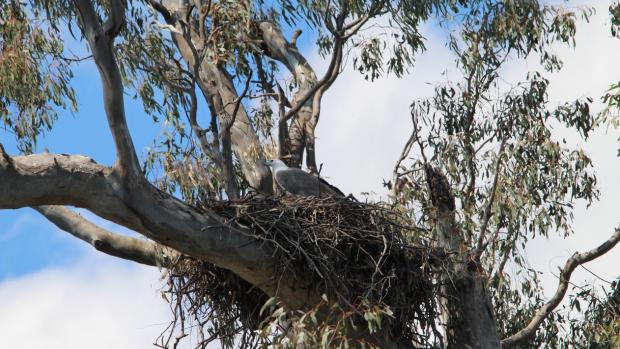Loading
The mosaic of Mother Nature

Perched in a spectacular nest high above the Little Reedy Wetland Complex on the Gunbower floodplain, a pair of threatened white-bellied sea eagles have worked together to successfully breed for the past three years.
The pair has relied on the health of the semi-permanent wetlands below to rear their chicks, and survive and thrive themselves.
However, it’s not only Australia’s second-largest raptor that relies on the health of the Little Reedy wetlands.
The complex is made up of three separate wetlands, and they are all very busy places.
They provide a mosaic of different types of habitat for a range of animals that all want different food, different resting areas and hiding places, different nesting materials and different places to sun themselves or hide from the elements.
“Water is central to providing all that,” North Central Catchment Management Authority (CMA) Acting Program Delivery Executive Manager Rohan Hogan said.
“Whether it’s helping to grow the flowers and seeds, rushes or reeds or small fish and waterbugs, the right amount of water at the right times means life for all different kinds of animals.
“The last thing any waterway needs is to become a monoculture.”
Little Reedy Wetland Complex is home to a whole raft of fish, water birds, rakali, mammals, frogs, turtles and wetland plants, and the current dry conditions have been tough on them all.
Victorian Environmental Water Holder co-Chief Executive Officer Beth Ashworth said dry conditions have affected farmers, communities and the environment across the Murray-Darling Basin.
“We can’t water everything in a dry year and have to make careful choices about which parts of the environment we can look after,” she said.
“So we are focusing on our highly productive wetland habitats such as the Little Reedy Wetland Complex that support a large range of different ecological values.”
To help these animals, and build resilience if the current dry conditions continue, up to six gigalitres of water for the environment will top-up the wetland complex from mid July.
“With moderate rainfall over winter so far and carryover available for both irrigators and the environment, the top-up will provide an important drink for native plants and animals, especially the birds and small-bodied native fish,” Mr Hogan said.
“The timing of this top-up flow also coincides well with the spring pulse in the Murray River, which aims to refresh and protect habitat for native fish, waterbirds and other animals down the length of the river.”
Access to a handful of tracks around the Little Reedy Wetland Complex may be temporarily restricted over late winter and early spring due to water across access tracks.
However, the popular camping and fishing spots along Gunbower Creek and the Murray River will still be accessible, with the main 2WD tracks remaining open.
The Department of Environment, Land, Water and Planning’s facebook page (https://www.facebook.com/DELWPLoddonMallee/) will provide regular track closure updates.
The Gunbower water for the environment project is delivered by the North Central CMA in partnership with Goulburn–Murray Water, Murray-Darling Basin Authority, the Commonwealth Environmental Water Office, the Victorian Environmental Water Holder, DELWP and Parks Victoria.
It is part of The Living Murray program, a joint initiative of the New South Wales, Victorian, South Australian, Australian Capital Territory and the Commonwealth governments, coordinated by the MDBA.
